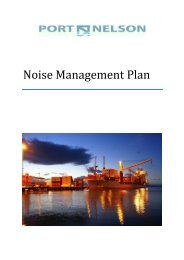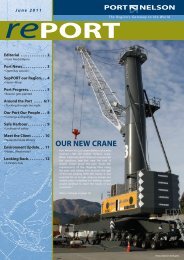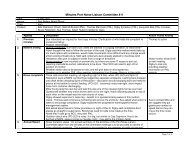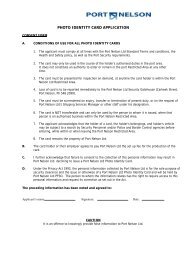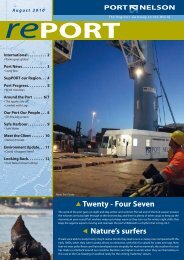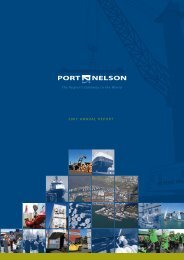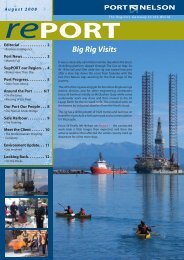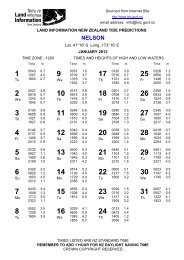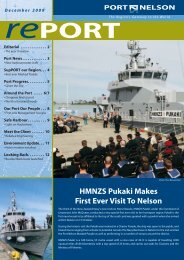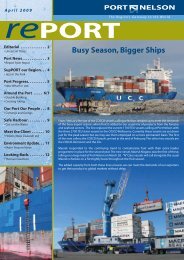Port Nelson Annual Report 2012 (pdf)
Port Nelson Annual Report 2012 (pdf)
Port Nelson Annual Report 2012 (pdf)
You also want an ePaper? Increase the reach of your titles
YUMPU automatically turns print PDFs into web optimized ePapers that Google loves.
our vision<br />
port people<br />
Percentage of Positives<br />
4.5%<br />
This year we set out defining our Vision and Purpose. In order to<br />
ensure that we captured input from all our people, we held companywide<br />
workshops and asked the fundamental questions of ‘why are we<br />
here?’ and ‘where are we going?’.<br />
The result was that our Purpose is clearly defined as ‘To facilitate<br />
regional prosperity’ and our Vision is to ‘Be the Benchmark – through<br />
continuous improvement’ with both encapsulating a strong part of<br />
our history and focus for the future.<br />
The Vision is underpinned by six pillars and a brief statement about<br />
what we want to achieve in these key areas over the next five years, as<br />
detailed throughout this report.<br />
Pre-implementation<br />
of Random Testing<br />
Post-implementation<br />
of Random Testing<br />
4.0%<br />
3.5%<br />
3.0%<br />
2.5%<br />
2.0%<br />
1.5%<br />
1.0%<br />
.5%<br />
0%<br />
developing capabilities<br />
New staff joining us, and increasing <strong>Port</strong> <strong>Nelson</strong>’s expertise, include:<br />
• Rob Hawkes, our new Customer Relations and Business Development<br />
Manager, brings a wealth of logistics experience in both marine and<br />
shore-based environments.<br />
• Our new Health and Safety Advisor, Lee-anne Ricketts, has been<br />
working with a wide range of the PNL team to identify future<br />
initiatives towards ‘zero harm’.<br />
• Nevin Price transferred from a marine role into project management<br />
and is working to progress our ‘Journey to Excellence’ (J2E) programme,<br />
identifying improvements to reduce waste using the team’s own ideas.<br />
Also joining us in permanent positions were Barry Cross, Workshop;<br />
Josef Beyer-Rieger, Security; Odile Gibbs, Finance and Administration;<br />
and Mike Cresswell, Stevedoring.<br />
health and safety training<br />
Continuing with the development of our Health and Safety (H&S)<br />
representatives, congratulations to both Paul Stent from Quaypack and<br />
Peter Moore from Stevedoring who attended Level 1 H&S representative<br />
training in May. Additionally, we rolled out our first tailored fall arrest<br />
systems on building and construction sites to our stevedores in August.<br />
Overall, the feedback from the course attendees was positive and all<br />
gained further skills in working safely at heights. Congratulations to all<br />
ten course attendees in achieving the unit standard.<br />
lost time injury<br />
We had seven LTIs this year, yielding an LTI Frequency Rate of 2.48<br />
compared to 3.89 in June 2011 and 2.75 in June 2010. While it is positive<br />
to see this reducing, there have still been seven of our people who have<br />
sustained an injury serious enough to require time off work. Reducing<br />
our accident rate to zero requires the ongoing focus of everyone in the<br />
prevention of accidents through proactive hazard management, being<br />
aware and alert on our safety-sensitive site, acting safely and watching<br />
out for each other. ‘Good Safety is Good Business’.<br />
random testing<br />
The random drug and alcohol testing programme is now well<br />
implemented at <strong>Port</strong> <strong>Nelson</strong>, having been in place since March 2011.<br />
The programme is an important monitoring tool for ensuring that<br />
our people are coming to the workplace fit for work. The following<br />
graph has been created using data from the last three financial years,<br />
with the information being split into pre and post-implementation of<br />
random testing.<br />
The graph provides a clear indication of the impact our random<br />
testing programme has had on our results.<br />
training<br />
Our training processes, trainer competency and module development<br />
have been the focus for the last year. In the past 12 months, we have<br />
developed and implemented 16 new Learner Guides for operational<br />
positions across Stevedoring, Marine and Logistics, that need to be<br />
completed before the trainee is deemed competent to work safely<br />
and efficiently alongside their fellow crew members.<br />
Our training team has increased in size by four people, as we’ve<br />
identified new trainers from Marine, Stevedoring, Logistics and<br />
Quaypack. All of our trainers have upskilled by attending training<br />
sessions on: How Adults Learn, Giving Trainees Effective Feedback<br />
and Creating Interest in Training.<br />
We have four staff that are 90 per cent through their National<br />
Certificate in Stevedoring and <strong>Port</strong>s, Level 3 with a completion date<br />
of December <strong>2012</strong>. Our intention is that more staff will acquire this<br />
qualification.<br />
The Vault software system is now well established as our way of<br />
storing all company training information, and we are now entering all<br />
Health and Safety, personal protective equipment, lifting equipment<br />
registers and contractor details into the system.<br />
employee survey<br />
In late 2011, we reported on the results of our Employee Survey, which<br />
was carried out by an independent survey company, JRA. The survey<br />
measures overall engagement levels and benchmarks the results<br />
against the best workplaces in New Zealand. We have an excellent<br />
response rate with 84 per cent of employees completing the survey.<br />
In terms of engagement, our results on employees who are prepared<br />
to ‘go the extra mile’ were similar to other companies. The survey<br />
confirmed that there is a general sense that our people enjoy<br />
the teamwork they experience in their roles. In addition, there<br />
were pleasing results around the priority placed on safety, the<br />
understanding and belief in our ASPIRE values, the expectations<br />
of a high level of performance, and awareness of how each role<br />
contributes to the success of the organisation.<br />
The survey also identified areas we can improve on, including<br />
providing more development opportunities, dealing effectively with<br />
poor performance, and better utilising our talent.<br />
13



